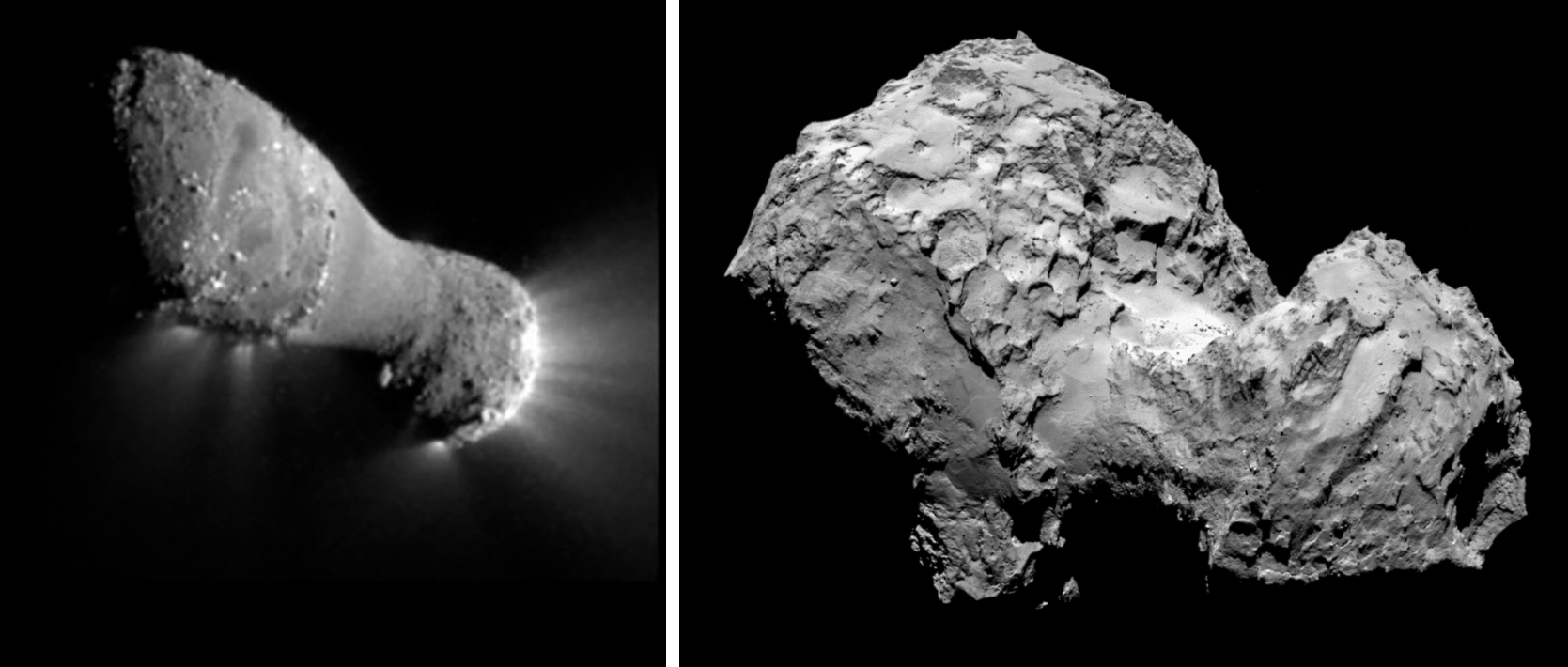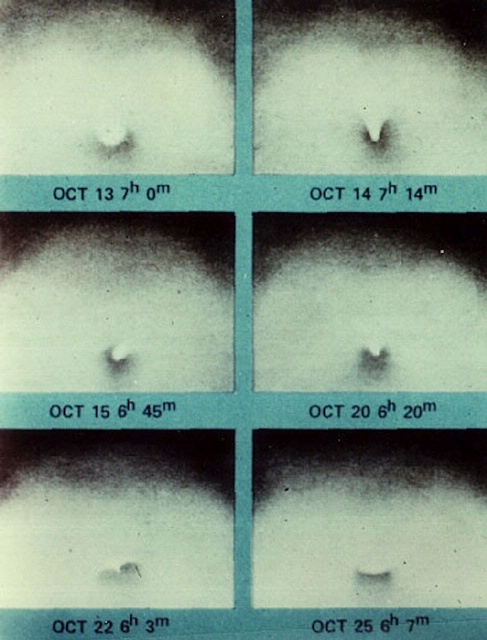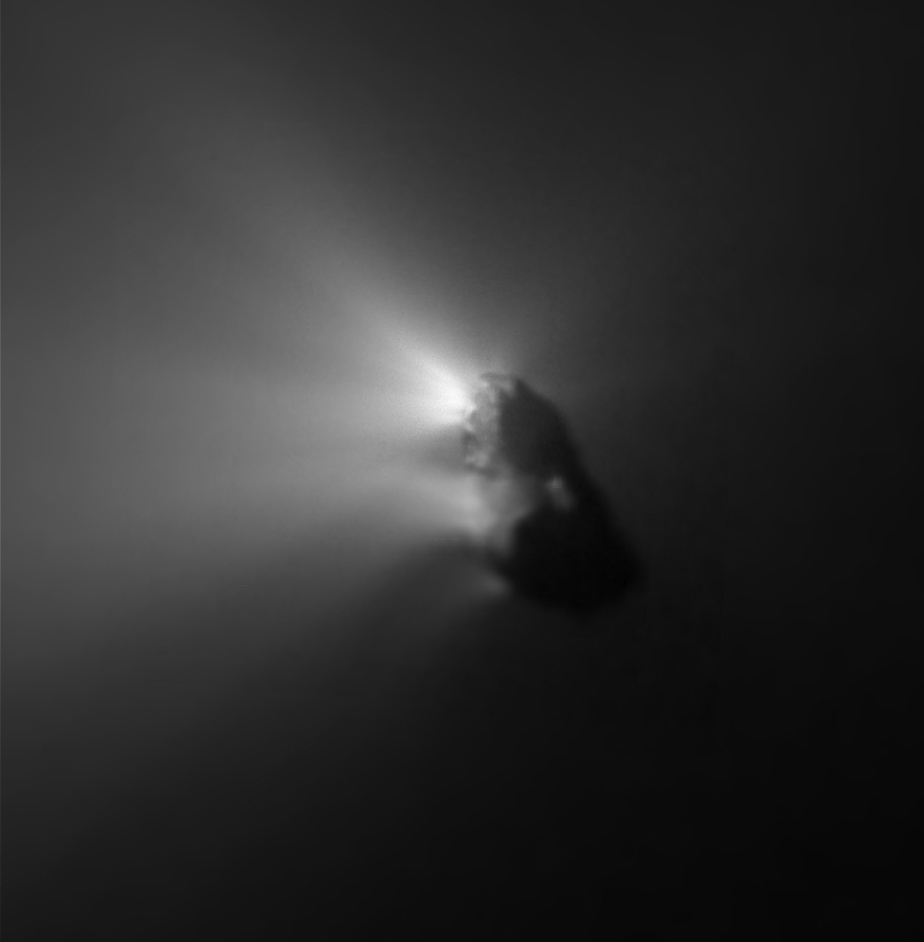
Once it had become clear that comets are bona fide members of the solar system just as planets and asteroids are, the question then becomes just what their physical nature might be. While they may appear to be fairly large in our nighttime sky, the fact that background stars shine through their tails and their comae undimmed indicates rather strongly that these are not solid but instead are mere clouds of material. Furthermore, while a comet that passes near a planet such as Jupiter will have its orbit strongly affected, the orbit of the planet itself is not affected by any measurable extent, indicating that a comet’s mass is negligible compared to that of a planet. Astronomers of the 19th and early 20th Centuries who studied comets that were passing close to Earth were unable to detect any kind of solid object in or near the center of their comae, suggesting that any such object had to be small, no more than a couple of hundred km across.
Once spectroscopic observations of comets began to be made during the 1860s these revealed the presence of several gaseous substances, including those containing carbon atoms. Meanwhile, studies of cometary tails had revealed that one of their primary constituents is dust, a conclusion that was reinforced once the relationship between comets and meteor showers was established during the latter decades of the 19th Century.
As is true with any scientific model, any explanation of a comet’s physical nature had to take all these various facts into account. One of the early widely accepted explanations of a comet was the so-called “flying sandbank” model developed in the 1880s by British astronomer Richard Proctor and championed most strongly in the early- to mid-20th Century by British astronomer Raymond Lyttleton. Within this model, comets are composed of a swarm of small solid dusty “objects,” the largest perhaps being a few meters in diameter, which would contain the various gases absorbed within them. As this “sandbank” approaches the sun the heat from sunlight would cause the objects within it to release these gases, producing the cometary effects we see such as the coma and the tail. Eventually, after the comet has made numerous returns to perihelion, all the gas would be released, and the comet would be nothing except a swarm of dust particles and a few larger objects, perhaps to form part of a meteor shower should Earth ever intercept it in the future.
This “flying sandbank” model, despite being the dominant theory for the structure of cometary nuclei for much of the first half of the 20th Century, suffered from several serious difficulties. Clearly, a comet would lose a significant amount of gas with each perihelion passage, and consequently its “lifetime” before running out of gas would be relatively short. Several comets, however – including 2P/Encke, which returns every 3.3 years – were observed at return after return after return with their supplies of gas seeming to undergo little change. To get around this, the idea was introduced that the “swarm” would accumulate additional gas as it traveled through the solar system, however it soon became clear that comets lost far too much gas when near the sun to ever be replenished by what they might sweep up during the rest of their travels.
What would prove to be the “flying sandbank’s” downfall, however, was a phenomenon first noticed in the 1820s by the German mathematician Johann Encke while studying observations of the comet that is named after him. Encke noted that, even after he allowed for all possible gravitational perturbations by the various planets, the comet was returning to perihelion a few hours earlier than predicted at each return. To account for this, Encke proposed a “resisting medium” in the solar system that was slowing the comet down and pushing it into a smaller orbit.

Throughout the remainder of the 19th Century a few other comets were seen to exhibit this phenomenon, which is now known under the name of “non-gravitational forces.” Despite the fact that there were problems with the idea, Encke’s idea of a “resisting medium” continued to hold for the most part . . . until the 1930s when two short-period comets were found to be accelerated into larger orbits – the exact opposite of what a “resisting medium” would do. While the “flying sandbank” model could be consistent with the effects of a “resisting medium,” it fell apart completely when confronted with these observed accelerations. The time had come for a new model.
In a series of papers, the first of which was published in March 1950, Harvard University astronomer Fred Whipple – who had spent the previous two decades studying phenomena associated with meteors and who managed to discover six comets in the process – proposed what he initially called his “icy conglomerate” model for a comet’s nucleus. In this model – which has come to be more popularly called the “dirty snowball” – a comet’s nucleus is a solid object made up of ices of various volatile gases which in turn have large amounts of dust grains embedded within them. Under the heat of sunlight these ices “sublimate” – i.e., turn directly from a solid into a gas, as will happen in the near-vacuum environment of space – and in this process the gas along with the embedded dust grains is ejected off the nucleus into the coma. The sunlight also breaks apart the parent molecules of these sublimated ices – water ice as well as other ices such as carbon monoxide and carbon dioxide – into the daughter molecules that were being spectroscopically detected at the time.
Non-gravitational forces can be accounted for in Whipple’s “dirty snowball” via an explanation first proposed as far back as 1835 by the German astronomer Friedrich Bessel, who during his observations of the inner coma of Comet 1P/Halley during its return that year noticed “jets” appearing to come from the center of the coma. Bessel reasoned that these “jets” were made up of material being ejected away from the comet, and in accordance with Isaac Newton’s Third Law of Motion – i.e., for every action there is an equal and opposite reaction – were pushing whatever was in the center in the opposite direction. In the face of the “resisting medium” Bessel’s idea didn’t gain much traction, but once Whipple’s “dirty snowball” model was published it fit in very well. Bessel’s “jets” were eruptions of the sublimated ices (and embedded dust grains) being ejected off the comet’s nucleus, and in turn were acting as small rocket engines, pushing the nucleus in the opposite direction. Since these eruptions could take place in any direction, some would act to push the comet into a smaller orbit, while others would accelerate it into a larger one – precisely what is observed.
Any good scientific model should be able to predict as-yet-unobserved phenomena. Once radio telescope technology had progressed to the point where valid observations of comets could be made, water and other “parent molecule” ices began to be detected in cometary comae beginning in the mid-1970s. A decade earlier the German physicist Ludwig Biermann had pointed out that, if water is indeed a predominant parent molecule in a comet’s nucleus, sunlight would break it apart into hydrogen and hydroxyl (OH), and the comet would be surrounded by a large cloud of hydrogen; this was first detected in early 1970 in the first comet observations ever made from space, of Comet Tago-Sato-Kosaka 1969g. (These observations were discussed in that comet’s “Comet of the Week” presentation four weeks ago.) Meanwhile, in November 1980 MIT astronomer Paul Kamoun utilized the giant Arecibo radio telescope in Puerto Rico to obtain rad

One perhaps surprising result from the Giotto images was the extreme blackness of Halley’s nucleus. As it turns out, when the surface ice is sublimated some of the dust gets left behind, and over time some of this surface dust starts to form a “crust” over parts of the nucleus – in part, creating some of the inactive regions on the nucleus that are apparent in the images. Also, while a significant portion of the erupted dust grains are ejected from the nucleus altogether and go into their own respective orbits around the sun – and producing future meteor showers here on Earth in the process – a fraction of that dust rains back down onto the surface. Examination of cometary dust grains obtained in the upper atmosphere show that they are very dark – blacker than soot – and accordingly it is easy to see how a cometary nucleus coated with these particles would appear black. (The collection and study of these grains is covered in a future “Special Topics” presentation.)
Giotto also found that there is a significant amount of formaldehyde and other organic compounds within Halley’s coma, material which obviously was erupted off the nucleus along with the other material. Detailed studies of various comets since then, both from Earth and from spacecraft missions, have revealed the presence of even more complex organic compounds, including various polymers, and have shown that they make up a non-trivial portion of a comet’s mass. The presence of such substances has significant implications both in the study of the natural history of Earth and the other planets, and, conceivably, as a platform for resource extraction; these are discussed in future “Special Topics” presentations.
Since the 1986 return of Comet 1P/Halley several other spacecraft missions have visited comets, the most dramatic of these missions being the European Space Agency’s Rosetta mission which orbited Comet 67P/Churyumov-Gerasimenko from 2014 to 2016 and deployed a lander, Philae, which although it was not as successful as had been hoped nevertheless was able to return some interesting results. As is perhaps to be expected, cometary nuclei are not all the same but instead seem to exhibit a variety of structural and compositional makeups, in some places being somewhat porous and in other places being very hard. 67P’s nucleus is a “contact binary,” a phenomenon that has been seen in several Earth-approaching asteroids, wherein two different objects collided and stuck together – becoming one object in the process – millions to billions of years ago. Several of these missions (including, certainly, Rosetta) and their destination comets are covered in future “Comets of the Week.”
One type of object that we have not yet been able to examine in close detail with a spacecraft is a long-period comet; while we might expect similarities with a short-period comet, there should also be significant differences as well. Due to the long time necessary to plan a spacecraft mission, as well as the usually short lead time we have of a long-period comet’s approach and the generally high orbital inclinations that they exhibit, it has not been really practical to put together such a mission – although with the current survey programs that are operational we do at least have a longer lead time nowadays. Last year ESA announced the initial development of a “Comet Interceptor” mission wherein a spacecraft would be launched and kept “in waiting” for the appearance of a suitable long-period comet. Comet Interceptor is among the planned spacecraft missions discussed in a future “Special Topics” presentation.
More from Week 10:
This Week in History Comet of the Week Bonus Content Free PDF Download Glossary
Ice and Stone 2020 Home Page


